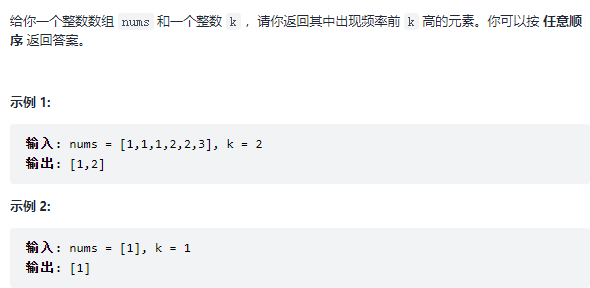703. 数据流中的第 K 大元素
/* 小根堆 */ typedef struct { int heapCapacity; int heapSize; int *heap; } KthLargest; /* 堆顶下标: 0; parent: (k-1)/2; leftChild: 2*k + 1; rightChild: 2*k + 2 */ int ParentIndex(int i) { return (i - 1) / 2; } int LeftChildIndex(int i) { return 2 * i + 1; } int RightChildIndex(int i) { return 2 * i + 2; } void Swap(int *a, int *b) { int tmp = *a; *a = *b; *b = tmp; } /************************************ 堆的有序性的维护 ************************************/ /* * 上浮: * 不符合规则的点(这里是小根堆,规则即父节点最小),与父节点交换(直至符合为止) */ void Swim(int *heap, int i) { while (i > 0 && heap[ParentIndex(i)] > heap[i]) { Swap(&heap[ParentIndex(i)], &heap[i]); i = ParentIndex(i); // 已经上浮一次,更新下次可能上浮的索引 } } /* * 下沉: * 不符合规则的点(这里是小根堆,规则即父节点最小),与子节点中较小的(因为是小根堆)交换(直至符合为止) */ void Sink(int *heap, int heapSize, int i) { while (LeftChildIndex(i) < heapSize) { int smallOneIndex = LeftChildIndex(i); int leftVal = heap[LeftChildIndex(i)]; if (RightChildIndex(i) < heapSize) { int rightVal = heap[RightChildIndex(i)]; // 比较子节点中哪个更小 smallOneIndex = leftVal < rightVal ? smallOneIndex : RightChildIndex(i); } if (heap[i] < heap[smallOneIndex]) { break; } Swap(&heap[i], &heap[smallOneIndex]); i = smallOneIndex; // 已经下沉一次,更新下次可能上浮的索引 } } /* * 出队: * 1.最后一个点换到根(根即待出队的点) * 2.下沉 */ void Pop(int *heap, int *heapSize) { Swap(&heap[0], &heap[*heapSize - 1]); // heap[*heapSize - 1] = 0; (*heapSize)--; Sink(heap, *heapSize, 0); } /* * 入队: * 1.待插入的点放在最后 * 2.上浮 */ void Push(int *heap, int *heapSize, int val) { heap[(*heapSize)++] = val; Swim(heap, *heapSize - 1); } /************************************ 答题 ************************************/ int kthLargestAdd(KthLargest* obj, int val) { if (obj->heapCapacity > obj->heapSize) { Push(obj->heap, &obj->heapSize, val); } else if (val > obj->heap[0]) { // 队列已经满了,并且头节点小于待插入的值 Pop(obj->heap, &obj->heapSize); Push(obj->heap, &obj->heapSize, val); } // 小根堆,每次返回头节点 return obj->heap[0]; } KthLargest* kthLargestCreate(int k, int* nums, int numsSize) { if (k < 1) { return NULL; } KthLargest *obj = (KthLargest *)malloc(sizeof(KthLargest)); obj->heapCapacity = k; obj->heapSize = 0; obj->heap = (int *)malloc(sizeof(int) * k); memset(obj->heap, 0, sizeof(int) * k); for (int i = 0; i < numsSize; i++) { if (obj->heapCapacity > obj->heapSize) { Push(obj->heap, &obj->heapSize, nums[i]); } else { // 堆已经满了,调用add接口 int ret = kthLargestAdd(obj, nums[i]); } } return obj; } void kthLargestFree(KthLargest* obj) { if (obj != NULL) { free(obj->heap); free(obj); } } /** * Your KthLargest struct will be instantiated and called as such: * KthLargest* obj = kthLargestCreate(k, nums, numsSize); * int param_1 = kthLargestAdd(obj, val); * kthLargestFree(obj); */
347. 前 K 个高频元素

解法1:直接用UT_HASH中的排序,返回前k个元素
struct hashTable { int key; // 数组元素 int value; // 数组元素出现的频率 UT_hash_handle hh; }; struct hashTable *g_hash; void AddNode(int num) { struct hashTable *tmp = NULL; HASH_FIND_INT(g_hash, &num, tmp); if (tmp == NULL) { tmp = (struct hashTable *)malloc(sizeof(struct hashTable)); tmp->key = num; tmp->value = 1; HASH_ADD_INT(g_hash, key, tmp); } else { (tmp->value)++; } } /* 排序:逆序 */ int HashCmp(struct hashTable *a, struct hashTable *b) { return b->value - a->value; } /** * Note: The returned array must be malloced, assume caller calls free(). */ int* topKFrequent(int* nums, int numsSize, int k, int* returnSize) { g_hash = NULL; for (int i = 0; i < numsSize; i++) { // 插入到hash表中 AddNode(nums[i]); } // 根据数组元素出现的频次,对hash表进行降序 HASH_SORT(g_hash, HashCmp); int *res = (int *)malloc(sizeof(int) * k); *returnSize = k; int cnt = 0; // 对hash表进行遍历 struct hashTable *cur, *tmp; HASH_ITER(hh, g_hash, cur, tmp) { if (cnt == k) { break; } res[cnt++] = cur->key; } return res; }
解法2:利用最小堆